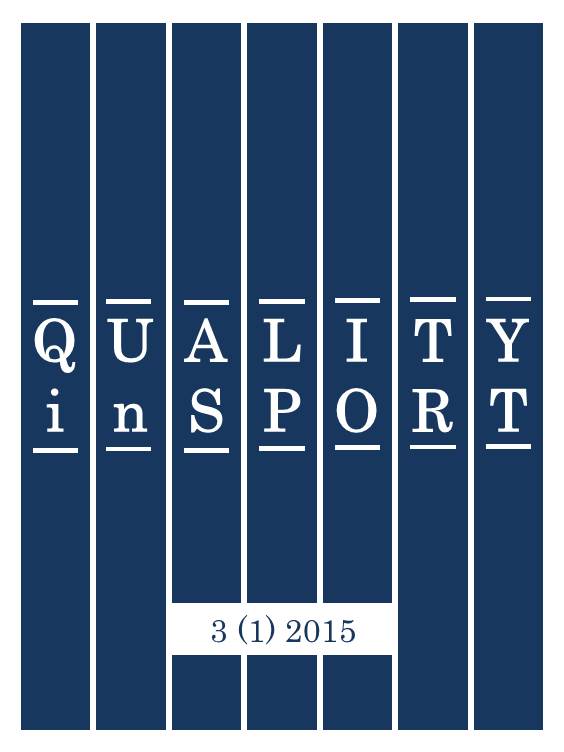Comparison of quality and organization of physical activities organized by University Sports Association at selected universities of the Upper Silesia
DOI:
https://doi.org/10.12775/QS.2015.015Keywords
quality, injury, control, gym, exercises, jakość, poprawność, uraz, kontrola, siłownia, ćwiczeniaAbstract
Introduction. Gym exercises have become more and more popular in the recent years. Thus, it is not surprising that this form of physical activity offered by University Sports Association has become a popular choice among the university students. However, to benefit from the workout, the exercises must be performed correctly. Application of excessive loads, number of repetitions, or poor technique can cause injury, which may lead to serious physical damage. Aim. The aims were to check the quality and organization of physical activities ogranized by University Sports Association in chosen universities of the Upper Silesia. The questions asked were:
1. Is there a correlation between different universities and the health control among new students at the gym?
2. Does the type of university correlate with the quality of the workout?
3. Is there a correlation between the type of university and the duration of the strength training?
Materials and Methods. 120 students were examined, among which there were 44 women aged 17 to 24 (x=20,8;SD= 1,8) and 76 man aged 17 to 28 (x=21,8; SD= 1,9). They were university students from the following Upper Silesian universities: ŚUM, AWF, UŚ and UE, who regularly practise gym exercises organized by Academic Sports Association. An original questionnaire was created for the purpose of this study. The questions concerned participation in the gym activities, choice of exercises in context of their health predispositions, presentation of the proper technique of exercises, information about synchronization exercises with breath and quality control of performed exercises without prior request of the students. Statistical analysis was performed by a program Statistica. Results. Analysis of variance (ANOVA) demonstrated a statistically significant relation between the type of university and the health control among new students at the gym (p=0,005). ŚUM is the university where the students are the most often controlled. There is no correlation between the type of university and the quality of the training (p=0,35). The duration of strength training is not correlated with the type of university. Students of AWF Katowice spend the most time at the gym, whereas students from ŚUM Katowice spend the least.
Conclusion
1. Frequency of the health control among students starting classes at the gym depends on the type of university.
2. The type of university does not affect the quality of the training.
3. The duration of training does not depend on the type of university.
References
Adamczyk J., Kowalski P, Boguszewski D., i wsp. Postawy prozdrowotne u mężczyzn regularnie ćwiczących na siłowni.
Allegre B, Souville M, Therme P, Griffiths M. Definitions and measures of exercise dependence. Addict. Rev. Theory 2006; 14: 631–646.
Bijnen F, Caspersen C, Feskens E i wsp: Aktywność fizyczna i umieralność w okresie 20 lat z powodu chorób sercowo-naczyniowych i wszystkich przyczyn. JAMA PL, 1999, 1,251.
Gail Goldberg, Otyłość, Wielka Brytania, tłumaczenie Elżbieta Wójtowicz.
Knapik A, i wsp. Znaczenie aktywności ruchowej w profilaktyce zdrowotnej. Zdr Publ 2004; 114, 3: 331-337.
Martinez-Gonzales, Martinez J.A., Hu F.B., Gibney M.J., Kearney J. (1999): Physical inactivity, sedentary lifestyle and obesity in the European Union. International Journal of Obesity 23: 1192-1201.
Odpowiedzi Rządu RP na pytania zawarte w Zielonej Księdze: „Promowanie zdrowego żywienia i aktywności fizycznej: europejski wymiar zapobiegania nadwadze, otyłości i chorobom przewlekłym” http://ec.europa.eu/health/ph_determinants/life_style/nutrition/green_paper/nutritiongp_co036_pl.pdf.
Osiński W. Antropomotoryka. AWF, Poznań 2003.
Przybylska A. Jak ćwiczyć prawidłowo? Ćwiczenia dla kobiet na siłowni i Sali. Landie.pl ltd, 2011.
Puchalski K. Świadomość i zachowania zdrowotne pracowników o niskim poziomie wykształcenia.
Schmidtbleicher D., Haas C. Nerwowe i biochemiczne aspekty treningu rehabilitacyjnego, 2004.
Sims J., Hill K., Davidson S., Gunn J., Huang N.: Wytyczne WHO dotyczące propagowania aktywności fizycznej wśród osób starszych. Rehabilitacja Medyczna 1996; 1: 53–54.
Starosta W.: Znaczenie aktywności ruchowej w zachowaniu i polepszaniu zdrowia człowieka. Lider 1997; 4: 3.
Szymocha M., i wsp. Epidemia otyłości w XXI wieku. Zdr Publ 2009; 119(2):207-212.
World Health Organisation. Obesity: Preventing and managing the global epidemic. WHO Technical Report Series 894. WHO, Geneva.
Wytyczne UE dotyczące aktywności fizycznej. Zalecane działania polityczne wspierające aktywność fizyczną wpływającą pozytywnie na zdrowie. Bruksela 2008. http://ec.europa.eu/sport/documents/pa_guidelines_4th_consolidated_draft_pl.pdf [15.01.2013].
Zalecenie Rady Unii Europejskiej w sprawie propagowanie we wszystkich sektorach prozdrowotnej aktywności fizycznej http://erasmusplus.org.pl/wp- content/uploads/2014/01/HEPA_Zalecenie _Rady.pdf [26.11.2013].
Downloads
Published
How to Cite
Issue
Section
Stats
Number of views and downloads: 335
Number of citations: 0



